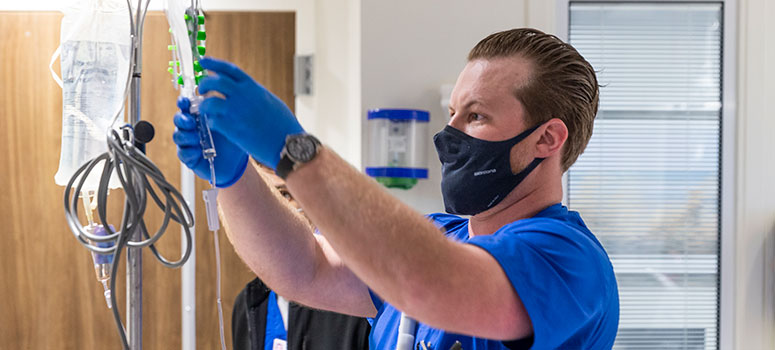What Does TIL Therapy Look Like?
Tumor-infiltrating lymphocyte, or TIL, therapy involves harvesting T cells found within a patient’s tumor, activating and expanding them in the lab, and reinfusing those cells into the patient to seek out and destroy cancer.
The cell manufacturing process takes on average between eight and 12 weeks. What happens during this time? Let’s take a look behind the scenes at Moffitt Cancer Center.
Surgery
Prior to surgery, the patient undergoes extensive screening and testing, including full body scans and blood work. During surgery, the surgical team removes a portion of a tumor containing T cells.

Thoracic surgeon Jobelle Baldonado, MD, right, leads a surgical team during a procedure to remove a portion of a patient’s tumor and collect T cells to begin the TIL process.
To the Lab
In the operating room, a piece of the tumor is put into a specimen cup and transported to the lab to begin the TIL process.

Alexander Dojcinovski, experimental cell therapies supervisor, transports a patient’s tumor and circulating T cells from the operating room at Moffitt McKinley Hospital to the cell therapies lab next door.
Expanding TILs
In the lab, the T cells are harvested and frozen. They are periodically thawed and mixed with a naturally occurring protein that encourages immune cells to grow. The T cells are tested to see which react most strongly to the tumor. The best killers are multiplied by the billions to be infused back into the patient.

Zachary Sannasardo, experimental cell therapy technologist, removes frozen T cells from liquid nitrogen to begin growing more cells.
Quality Control
Shortly before being infused back into the patient, the cells undergo several quality control checks to ensure safety and product quality. The cells are frozen again and transported back to the hospital. An average of five days prior to infusion, patients enter the hospital for a round of induction chemotherapy. The treatment reduces the number of circulating lymphocytes in the body to create a more favorable environment for the TIL.

Abraian Miller, experimental cell therapy technologist, examines the cells under a microscope during quality control testing.
Thawing
When the cells are ready to be infused, lab technicians thaw them gradually in a water bath. They are then transported to the patient, who has been admitted to the cellular therapy inpatient floor. They can spend four to 21 days there.

Sannasardo places a bag filled with TIL in a water bath to thaw before being infused into a patient.
Infusion
The nurse hangs the bag of cells and connects them to the patient’s central line to begin the infusion. After the infusion, the patient is given a drug called interleukin-2 every eight hours. The drug helps encourage immune cell growth but comes with intense side effects. Patients take only as many doses as they can tolerate.

Nurse Ivan Ross hangs a bag with the TIL to be infused into a patient.



